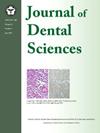不同颅牙面前后形态对三维微笑变量的影响
IF 3.1
3区 医学
Q1 DENTISTRY, ORAL SURGERY & MEDICINE
引用次数: 0
摘要
背景/目的临床面部评估的研究越来越多地转向三维(3D)方法。本横断面研究考察了三维微笑变量与两种前后颅牙面形态(overjet [OJ]和a点- b点角度[ANB])之间的关系,并量化了从静止到摆姿微笑过渡过程中的面部软组织位移。材料与方法本研究纳入119名年龄在18-30岁之间的参与者。它们被分为3个OJ组(0 -4 mm, >;4 mm和<;0 mm)和3个ANB组(0°-4°,>;4°和<;0°)。在休息和微笑时拍摄3D面部图像。随后,对地标位置进行分析。获得了线性、角度和比例测量结果,并测量了地标位移。结果在257个三维软组织变量中,41个在3个OJ组中有显著差异,46个在3个ANB组中有显著差异。ANB组1在微笑时测得的关节间宽度比其他两组更显著。ANB组3在休息和微笑时的唇角较大,而OJ组2在休息时的唇角较小。OJ组3和ANB组3对下唇运动的限制明显大于1、2组。结论oj和ANB主要影响微笑时的软组织标志。大的OJ可能导致深唇沟,而阴性的ANB可能导致扁平的唇沟。反向OJ和III类骨骼错牙合通过限制下唇的运动而影响下唇。本文章由计算机程序翻译,如有差异,请以英文原文为准。
Effects of varying anteroposterior craniodentofacial morphologies on three-dimensional smile variables
Background/purpose
Research regarding clinical facial assessment has increasingly shifted toward three-dimensional (3D) methods. This cross-sectional study examined the associations between 3D smile variables and two anteroposterior craniodentofacial morphologies (overjet [OJ] and point-A-nasion-point-B angle [ANB]) and quantified facial soft tissue displacement during the transition from rest to posed smiles.
Materials and methods
This study included 119 participants aged 18–30 years. They were divided into three OJ groups (0–4 mm, >4 mm, and <0 mm) and three ANB groups (0°–4°, >4°, and <0°). 3D facial images were taken at rest and during smiling. Subsequently, landmark positions were analyzed. Linear, angular, and proportional measurements were obtained, and landmark displacements were measured.
Results
Of the 257 3D soft tissue variables considered, 41 differed significantly among the 3 OJ groups, and 46 differed significantly among the 3 ANB groups during smiling. The intercommissural width measured during smiling in ANB group 1 was more significant than that in the other two groups. Labiomental angles were larger in ANB group 3 at rest and during smiling, whereas the angle at rest was smaller in OJ group 2. Lower lip movements in OJ group 3 and ANB group 3 were more restricted than those in groups 1 and 2.
Conclusion
OJ and ANB primarily affect soft tissue landmarks during smiling. A large OJ may lead to a deep labiomental sulcus, whereas a negative ANB may result in a flattened sulcus. Reverse OJ and Class III skeletal malocclusion affect the lower lip by restricting its movement.
求助全文
通过发布文献求助,成功后即可免费获取论文全文。
去求助
来源期刊

Journal of Dental Sciences
医学-牙科与口腔外科
CiteScore
5.10
自引率
14.30%
发文量
348
审稿时长
6 days
期刊介绍:
he Journal of Dental Sciences (JDS), published quarterly, is the official and open access publication of the Association for Dental Sciences of the Republic of China (ADS-ROC). The precedent journal of the JDS is the Chinese Dental Journal (CDJ) which had already been covered by MEDLINE in 1988. As the CDJ continued to prove its importance in the region, the ADS-ROC decided to move to the international community by publishing an English journal. Hence, the birth of the JDS in 2006. The JDS is indexed in the SCI Expanded since 2008. It is also indexed in Scopus, and EMCare, ScienceDirect, SIIC Data Bases.
The topics covered by the JDS include all fields of basic and clinical dentistry. Some manuscripts focusing on the study of certain endemic diseases such as dental caries and periodontal diseases in particular regions of any country as well as oral pre-cancers, oral cancers, and oral submucous fibrosis related to betel nut chewing habit are also considered for publication. Besides, the JDS also publishes articles about the efficacy of a new treatment modality on oral verrucous hyperplasia or early oral squamous cell carcinoma.
 求助内容:
求助内容: 应助结果提醒方式:
应助结果提醒方式:


